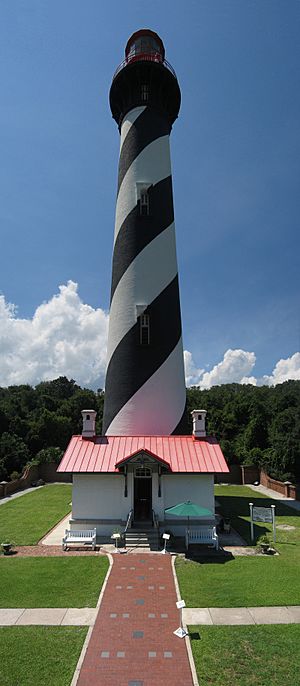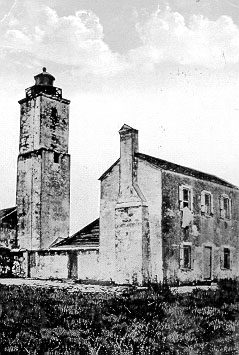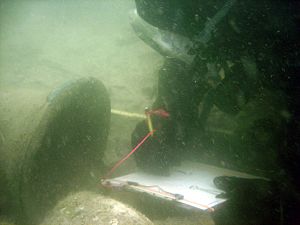St. Augustine Light facts for kids
 |
|
| The St. Augustine Light tower was built in 1874 | |
| Location | Anastasia Island, Florida |
|---|---|
| Coordinates | 29°53′08″N 81°17′19″W / 29.88543°N 81.28852°W |
| Year first lit | first tower, ca. 1737; second tower, 1874 |
| Automated | 1955 |
| Foundation | first tower, coquina; second tower, brick on coquina |
| Construction | first tower, coquina; second tower, brick |
| Tower shape | first tower, square tower; second tower, conical tower |
| Height | first tower, 52 feet (16 m); second tower, 165 feet (50 m) |
| Original lens | 1824: Winslow Lewis lamps with replectors; 1855: fourth order Fresnel lens; 1874: first-order Fresnel lens |
| Range | 1874: fixed lamp, 17 nautical miles; 31 kilometres (19 mi) flashing lamp, 21 nautical miles; 39 kilometres (24 mi) |
| Characteristic | prior to 1936, 3 minute fixed flash; in 1936 changed to 30-second flash |
The St. Augustine Light Station is a special place in St. Augustine, Florida. It's a working lighthouse that helps ships find their way. This lighthouse is located at the north end of Anastasia Island. It was built between 1871 and 1874.
This tower is actually the second lighthouse in St. Augustine. The first one was officially lit in May 1824. It was Florida's very first lighthouse! But even before that, Spanish and British governments used watchtowers and beacons here. These early navigation aids date all the way back to 1565.
Today, the lighthouse tower, its original lens, and the surrounding area are owned by the St. Augustine Lighthouse & Maritime Museum, Inc.. This is a non-profit museum. It's open to visitors almost every day of the year. The money from tickets helps keep the lighthouse and five other old buildings in good shape. It also helps fund programs about maritime archaeology (studying old things from the sea), building traditional wooden boats, and learning about the ocean. The museum's goal is to "discover, preserve, present and keep alive the stories of the nation's oldest port as symbolized by our working St. Augustine Lighthouse."
Contents
History of the St. Augustine Lighthouse
St. Augustine was home to Florida's first lighthouse. The American government built it in 1824. Old records and maps show this lighthouse was on the same spot as an even older watchtower. The Spanish built that watchtower in the late 1500s.
A map from 1589, showing Sir Francis Drake's attack on St. Augustine, shows an early wooden watchtower. It was near a Spanish building and was called a "beacon." By 1737, the Spanish built a stronger tower. They used coquina, a soft rock made of shells, from a nearby quarry. We're not sure if the Spanish used this coquina tower as a lighthouse. But it's likely, because there was a lot of ship trade back then. People often called it a "lighthouse" in documents and ship logs from the British time, starting in 1763.
Changes Over Time
In 1783, the Spanish took control of St. Augustine again. They improved the lighthouse once more. An engineer named Joseph Frederick Wallet DesBarres marked a coquina "Light House" on Anastasia Island in 1780. Another expert, Jacques-Nicolas Bellin, called the coquina tower a "Batise" in his book. Experts still discuss how accurate these old maps are. DesBarres's work has some mistakes, but Bellin is considered very good. His work helps us understand St. Augustine's geography in 1764.
The old tower was slowly worn away by the ocean. It finally fell into the sea in 1880. But a new lighthouse was already shining by then. Today, the ruins of the old tower are an underwater archaeological site.
Lamps and Lenses
The first lamps in the old tower burned lard oil. Later, in 1855, a special Fresnel lens was added. This lens made the light much brighter and helped it shine farther. It also made the lighthouse easier to maintain.
During the American Civil War, a local harbor master named Paul Arnau and the lightkeeper, Maria Mestre de los Dolores Andreu, removed the lens. Maria Andreu was the first Hispanic-American woman to work for the Coast Guard. They hid the lens to stop Union ships and help blockade runners. The lens was found later after Arnau was forced to tell where it was.
Building the New Lighthouse
By 1870, the beach was eroding and threatening the first lighthouse. So, construction on a new, taller lighthouse began in 1871. While it was being built, a wall of coquina and brush was made to protect the old tower. Building materials were brought by a trolley track from ships at the dock.
The new tower was finished in 1874. It started working with a new, powerful Fresnel lens. William Russell was the first keeper in the new tower. He was also the only keeper who worked in both the old and new lighthouses.
For 20 years, William A. Harn was the head keeper. He was a war hero. He and his wife, Kate Skillen Harn, had six daughters. Their family was known for serving lemonade on the porches of the keepers' house. This house was built as a two-family home during Harn's time.
On August 31, 1886, a big earthquake in Charleston made the tower "sway violently." But the lighthouse was not damaged. In 1885, the lamp's fuel was changed from lard oil to kerosene.
During World War II, Coast Guard members used the lighthouse as a lookout. They watched for enemy ships and submarines along the coast. In 1907, the lighthouse got indoor plumbing. In 1925, the keepers' house got electricity. The light itself became electric in 1936 and was automated in 1955. This meant fewer keepers were needed. By the 1960s, families no longer lived in the keepers' house. It was rented out and later bought by St. Johns County in 1970. Sadly, the house was badly damaged by a fire that year.
Restoring the Lighthouse
In 1980, a small group of 15 women from the Junior Service League of St. Augustine (JSL) started a big project. They leased the keepers' house and grounds for 99 years. They began a huge restoration effort. Soon after, the JSL also leased the lighthouse tower from the Coast Guard for 30 years. The lighthouse was then added to the National Register of Historic Places in 1981. This was thanks to the hard work of Karen Harvey, a local historian.
The old lens worked until it was damaged by rifle fire in 1986. Nineteen of its prisms were broken. The FBI looked into this crime. The Coast Guard thought about replacing the damaged lens with a modern airport light. But the JSL fought this idea. The 9-foot (2.7 m)-tall lens was repaired. Retired Coast Guardsmen Joe Cocking and Nick Johnston helped with this. It was the first time such a restoration had been done in the country. They still help care for the lens today. Volunteers from Northrop Grumman and Florida Power & Light clean and check the lens every week.
Today, the St. Augustine Light Station includes the 165-foot (50 m) tower from 1874. It also has the 1876 Keepers' House, two summer kitchens from 1886, a 1941 U.S. Coast Guard building, and a 1936 garage. The garage was used to fix jeeps during World War II. The site is also a National Oceanic and Atmospheric Administration weather station.
St. Augustine Lighthouse & Maritime Museum
In 1994, the Lighthouse Museum of St. Augustine opened to the public full-time. A group of local trustees was formed in 1998. These volunteers help protect the site for future generations. In 2002, the ownership of the tower and its historic lens was transferred. It went from the U.S. Coast Guard to the St. Augustine Lighthouse and Museum, Inc. This was the first time a U.S. lighthouse was given to a non-profit group. The Museum keeps the light shining as a private aid for ships. In 2016, the museum changed its name to the St. Augustine Lighthouse & Maritime Museum.
The St. Augustine Lighthouse & Maritime Museum works to save local maritime history. It tells the story of America's oldest port. It also helps young people learn about marine sciences. The museum staff and board also help save other lighthouses in Florida and across the country. They work with federal agencies and groups like the Florida Lighthouse Association. The Lighthouse employs about 50 people. Over 200,000 people visit each year, including 54,000 school-aged children.
Exploring Maritime History
The museum has an active archaeological program called the Lighthouse Archaeological Maritime Program (LAMP). LAMP studies old maritime sites around St. Augustine. Their archaeologists have found many historic shipwrecks. They also investigate other sites like old wharves and the remains of St. Augustine's original lighthouse.
The museum also studies other parts of maritime heritage. This includes boat building and the history of the local shrimping industry. They have a growing collection of World War II items, especially about the U.S. Coast Guard in St. Augustine. The Keeper's house has exhibits about these parts of St. Augustine's history. The Lighthouse also has a volunteer program that builds traditional wooden boats.
Lighthouse Archaeological Maritime Program (LAMP) Discoveries
The St. Augustine Lighthouse & Maritime Museum has funded maritime archaeology since 1997. In 1999, they officially started LAMP. LAMP is one of the few research groups in the country that hires full-time marine archaeologists and conservators. Most others are part of universities or the government.
LAMP's first director was William "Billy Ray" Morris. He led the research until 2005. In 2006, underwater archaeologist Chuck Meide became the new director. Today, LAMP has three archaeologists and three conservators. They also have many volunteers and student interns.
The oldest shipwreck found in St. Augustine waters is the Industry. This British supply ship sank on May 6, 1764. It was carrying supplies for British soldiers in Florida. Items from the wreck, like cannons, tools, and anchors, were well-preserved. They show us what British soldiers needed back then. Many of these items are now on display in the museum.
In 2009, LAMP archaeologists found another old shipwreck, called the "Storm Wreck." This ship was completely buried when found. They have dug it up each summer from 2010 to 2012. It seems to be scattered pieces of cargo, ship parts, military gear, and personal items. Archaeologists and divers have found many well-preserved items. These include iron and copper pots, pewter spoons, glass, buckles, a brass candlestick, and three Brown Bess muskets. They also found military buttons, a cask of nails, tools, and a bronze ship's bell. They also found a 4-pounder cannon and a 9-pounder carronade. This carronade is believed to be the second oldest in the world.
After studying the items, they believe this ship was part of the December 18, 1782, evacuation of Charleston. It was carrying people and troops to St. Augustine at the end of the American Revolution. Many ships were lost on the sandbar in front of St. Augustine during this time. In 2015-2016, LAMP found three more historic shipwrecks. They are currently digging up one from the late 1700s, called the "Anniversary Wreck."
LAMP has also dug up two important 19th-century wrecks near St. Augustine. One was a wooden steamship, and the other was a schooner. We don't know their names, but studying them helps us understand St. Augustine's growth. The schooner carried cement, likely for the city's building boom in the late 1800s. LAMP has also looked at many shipwrecks found on beaches. They have also explored other archaeological sites in Florida. These include British plantation landings, old boatyard foundations, and colonial wharves. Current work focuses on the First Coast Maritime Archaeology Project. This project studies the waters around St. Augustine and northeast Florida.
Ghost Stories
Some people who look for ghosts say the lighthouse and its buildings have a history of strange activity. The lighthouse has been shown on TV shows like Ghost Hunters and My Ghost Story.
However, researcher Joe Nickell has investigated and says there is no real proof the lighthouse is haunted. He believes that any spooky noises are just things like seagulls or the wind. The St. Augustine Lighthouse was also featured on the TV show Most Terrifying Places in America in an episode called "Restless Dead" in 2018.





